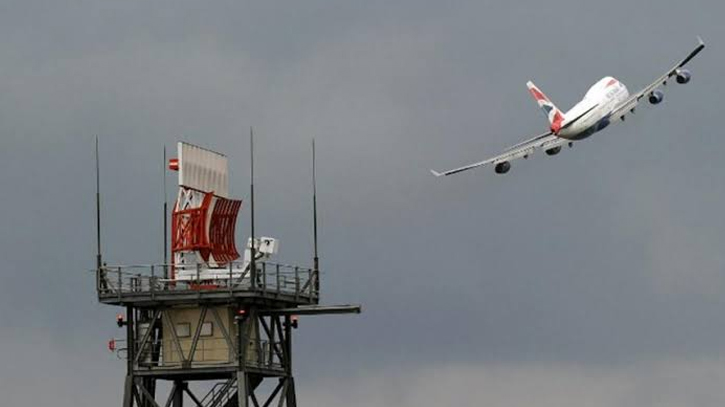
Photo: Collected
Bangladesh's airspace is now more secure and integrated. A new Tk 7.3 billion radar from French company Thales, featuring advanced technology, is fully operational at Hazrat Shahjalal International Airport (HSIA). The Bangladesh Air Force operates its own radar system, while another in Chattogram is nearing activation. These developments have significantly enhanced the country's airspace security and integration.
Initially, there was controversy over the cost of installing the radar. To resolve this, Prime Minister Sheikh Hasina personally consulted with the French President and decided to proceed with the radar installation through a government-to-government (G2G) agreement. Consequently, in April 2021, the government approved a project titled ‘Installation of CNS-ATM (Communication, Navigation, and Surveillance-Air Traffic Management) System’, Including Radar at Hazrat Shahjalal International Airport.
On June 8, 2021, the Cabinet Committee on Government Purchase approved this project, named ‘Modernisation of CAAB's Communication, Navigation, Surveillance, and Air Traffic Management - Installation of CNS-ATM System Including Radar at Hazrat Shahjalal International Airport,’ with an estimated cost of about Tk 7.3 billion.
This expense is being covered by CAAB's own funds. CAAB signed a contract with the French radar manufacturer Thales in October 2021 for the project’s implementation. The radar was installed in November 2023 and has gradually started operation. It is now fully operational.
Air Commodore Ziaul Haque, Member (Air Traffic Management-ATM) of the Civil Aviation Authority of Bangladesh, told The Daily Messenger, “The newly installed radar at Shahjalal Airport is now fully operational. This radar, built with state-of-the-art technology, has further strengthened the monitoring of the country’s airspace. Our international standing has also been enhanced due to the new Air Traffic System (ATS).”
In response to a question, he added, “There is some confusion about our ATS. Various rumors have spread due to some technical issues. Alongside our advanced radar system, the Air Force has its own radar, which we also use for observation. Additionally, another radar in Chattogram is waiting to become operational. There is no possibility for any aircraft to evade our country's airspace.”
He also mentioned, “We are currently generating significant revenue through ATM.”
CAAB sources have said that misleading and false information about the country’s airspace, as well as incorrect details about the radar installed in Chattogram, have been circulating for some time. Although the previously installed radar at Shahjalal was very old, it remained operational through upgrades and overhauls. Both the old and newly installed radars are from the same company, allowing CAAB’s Air Traffic Control (ATC) to provide 24-hour surveillance and control using state-of-the-art radar technology. As a result, there has always been no opportunity for aircraft to evade detection and cross Bangladesh's airspace undetected, and this remains true with the new radar.
CAAB said that the entry of any aircraft into Bangladesh's airspace is predetermined. Overflying charges apply in such cases. If an aircraft enters the country’s airspace for even one minute, it must be reported, and charges are applicable. In addition to CAAB’s radar, the Air Force operates multiple radars to monitor Bangladesh's airspace.
Sources indicate that although traffic is not controlled by the radar in Chattogram, the southern part of Bangladesh, including the maritime boundary, is fully monitored by the Dhaka radar. A radar was installed in Chattogram in 2017 with assistance from JICA, but its commissioning was delayed due to various administrative complications and later by the COVID-19 pandemic. It became operational in 2022 but was halted due to technical errors. Currently, efforts are underway to resolve these issues through NEC Company in Japan, and it is expected to be operational again very soon.
CAAB sources also revealed that overflying income over the past nine fiscal years was close to Tk 20 billion. This amount fluctuated between Tk 15 and 18 billion. However, with the installation of the new radar, income is expected to rise to between Tk 25 and 30 billion. In the 2023-24 fiscal year, overflying income was around Tk 19 billion, compared to Tk 17 billion in the 2022-23 fiscal year, and Tk 14 billion during the COVID period in the 2021-22 fiscal year. The income was Tk 15 billion in the 2019-20 fiscal year, over Tk 17 billion in the 2018-19 fiscal year, and Tk 16 billion in the 2017-18 fiscal year. In the 2016-17 fiscal year, the revenue was Tk 15.6 billion, Tk 13.3007 billion in the 2015-16 fiscal year, and Tk 12.21 billion in the 2014-15 fiscal year.
Messenger/Disha








